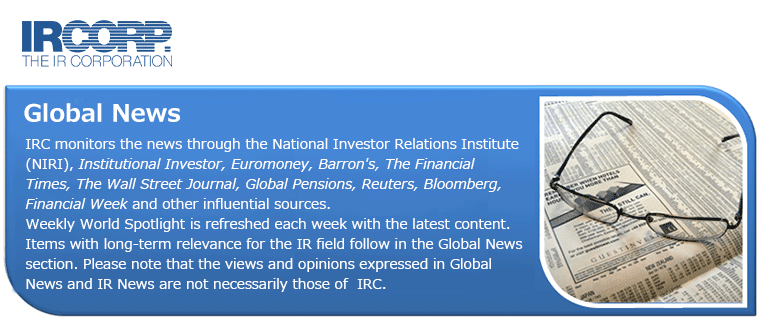Washington Post (March 11)
An “epidemic of stagnant wages” continues in the U.S. despite robust job growth. In February, the “official unemployment fell to its lowest rate since early 2008. Wages, however, increased by an anemic 0.1 percent. Over the previous 12 months, they increased just 2 percent. Factoring in inflation, they’ve barely increased at all.”
Tags: Growth, Inflation, Jobs, Stagnant wages, U.S., Unemployment
Wall Street Journal (March 11)
“Having attacked everything else, Apple is going after the last screen left. But where’s the big innovation?” This missing element may explain the “subdued” reaction greeting Apple’s roll out of the iWatch.
Tags: Apple, Innovation, iWatch, Reaction, Screen
Institutional Investor (March 10)
“China’s red-hot growth inevitably has to cool given that it has already overbuilt and overborrowed. China’s debt load has exploded four-fold since 2007, largely on the back of shadow banking and a real estate boom.” China’s total debt load (estimated at 282% of GDP by McKinsey) now “tops debt loads in the U.S., Germany, Australia and other developed countries. China’s corporate debt amounts to 125 percent of GDP.”
Tags: Australia, Boom, China, Debt load, GDP, Germany, Growth, McKinsey, Overborrowed, Overbuilt, Real estate, Shadow banking, U.S.
New York Times (March 9)
“Ebola demonstrated that oceans are no longer an obstacle to a raging virus. As this outbreak winds down, all involved must ensure that the next germ never gets as far as this one did and that, once zero is reached, Ebola stays at zero.”
Bloomberg (March 8)
“China’s second interest-rate cut in three months has raised fears that the government is trying to devalue the yuan to give its exports an unfair boost — an understandable suspicion.” In this case, however, “lower interest rates and a moderately weaker yuan make sense not just for China but for the rest of the world as well.” These factors should help Chinese leaders achieve their “soft landing” growth target of 7%. “The rest of the world no less than China needs this soft landing to be smoothly accomplished.”
Tags: China, Devalue, Exports, Government, Growth, Interest rate, Soft landing, Yuan
The Economist (March 7)
“Twenty-five years after the Soviet collapse, the world is entering a new nuclear age. Nuclear strategy has become a cockpit of rogue regimes and regional foes jostling with the five original nuclear-weapons powers (America, Britain, France, China and Russia), whose own dealings are infected by suspicion and rivalry.” The new nuclear age is far more unstable. “During much of the cold war the two superpowers, anxious to avoid Armageddon, were willing to tolerate the status quo. Today the ground is shifting under everyone’s feet.”
Tags: Armageddon, China, Cold war, France, Nuclear age, Regional foes, Rivalry, Rogue regimes, Russia, Strategy, Superpowers, Suspicion, U.S., UK
Financial Times (March 6)
The European Central Bank’s “meeting on Thursday was a rare example of the ECB having some good news to celebrate. Not only were there signs of revival in the economy, but the prospect of a happier future was increased by its decision to push ahead with its entirely appropriate programme of quantitative easing (QE).” The ECB “should continue with the programme until the trickle of good news has become a sustained and steady flow.”
Tags: ECB, Economy, Good news, Quantitative easing, Revival
Wall Street Journal (March 5)
The European Central Bank (ECB) hasn’t even actually started its quantitative easing (QE) activities. Somehow, however, its QE program “is working before it has even begun.” The euro has fallen 20% since last summer and, this week, dropped to $1.10, an eleven year low. How? “As investors came to view QE as inevitable, prices responded, especially the price of the euro. As a result of Mr. Draghi’s open-mouth operations to talk down the euro—coupled with an expectation that interest rates might rise soon in the U.S.—the euro has declined steadily against the dollar and other currencies.” Whether the actual QE program will be able to duplicate this pregame success remains to be seen.
Tags: Currencies, Dollar, Draghi, ECB, euro, Interest rates, Investors, Quantitative easing, U.S.
Washington Post (March 5)
There has been a “great shift in what U.S. corporations have done with their money.” Companies once invested 40% of “every dollar that a corporation either borrowed or realized in net earnings.” This “went into investment in its facilities, research or new hires. Since the ’80s, however, just 10 cents of those dollars have gone to investment…. The money that once went to expansion and new ventures has gone instead into shareholders’ pockets.”
Tags: Corporations, Earnings, Expansion, Facilities, Investment, Research, Shareholders, Shift, U.S.
New York Times (March 3)
Warren Buffet’s annual letter to Berkshire Hathaway shareholders really let the finance industry have it. “Mr. Buffett has long ridiculed the financial industry, but this year’s letter, laced with references to bankers, lawyers and consultants as ‘a lot of mouths with expensive tastes,’ seemed to amp up the pugnacity.”


